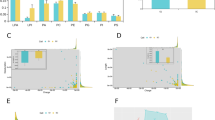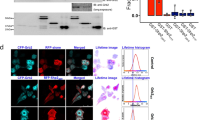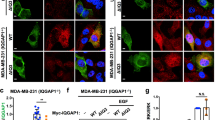Abstract
The membrane-linked docking protein SNT-2/FRS2β/FRS3 becomes tyrosine phosphorylated in response to fibroblast growth factors (FGFs) and neurotrophins and serves as a platform for recruitment of multiple signaling proteins, including Grb2 and Shp2, to FGF receptors or neurotrophin receptors. We previously reported that SNT-2 is not tyrosine phosphorylated significantly in response to epidermal growth factor (EGF) but that it inhibits ERK activation via EGF stimulation by forming a complex with ERK2. In the present report, we show that expression of SNT-2 suppressed EGF-induced cell transformation and proliferation, and expression level of SNT-2 is downregulated in cancer. The activities of the major signaling molecules in EGF receptor (EGFR) signal transduction pathways, including autophosphorylation of EGFR, were attenuated in cells expressing SNT-2 but not in cells expressing SNT-2 mutants lacking the ERK2-binding domain. Furthermore, SNT-2 constitutively bound to EGFR through the phosphotyrosine binding (PTB) domain both with and without EGF stimulation. Treatment of cells with MEK inhibitor U0126 partially restored the phosphorylation levels of MEK and EGFR in cells expressing SNT-2. On the basis of these findings, we propose a novel mechanism of negative control of EGFR tyrosine kinase activity with SNT-2 by recruiting ERK2, which is the site of negative-feedback loop from ERK, ultimately leading to inhibition of EGF-induced cell transformation and proliferation.
This is a preview of subscription content, access via your institution
Access options
Subscribe to this journal
Receive 50 print issues and online access
$259.00 per year
only $5.18 per issue
Buy this article
- Purchase on Springer Link
- Instant access to full article PDF
Prices may be subject to local taxes which are calculated during checkout







Similar content being viewed by others
References
Buday L, Downward J . (1993). Cell 73: 611–620.
Canagarajah BJ, Khokhlatchev A, Cobb MH, Goldsmith EJ . (1997). Cell 90: 859–869.
Chen C, Okayama H . (1987). Mol Cell Biol 7: 2745–2752.
Dhalluin C, Yan KS, Plotnikova O, Lee KW, Zeng L, Kuti M et al. (2000). Mol Cell 6: 921–929.
Gotoh N, Ito M, Yamamoto S, Yoshino I, Song N, Wang Y et al. (2004a). Proc Natl Acad Sci USA 101: 17144–17149 [E-pub 2004 Nov 29].
Gotoh N, Laks S, Nakashima M, Lax I, Schlessinger J . (2004b). FEBS Lett 564: 14–18.
Gotoh N, Manova K, Tanaka S, Murohashi M, Hadari Y, Lee A et al. (2005). Mol Cell Biol 25: 4105–4116.
Gotoh N, Muroya K, Hattori S, Nakamura S, Chida K, Shibuya M . (1995). Oncogene 11: 2525–2533.
Gotoh N, Tojo A, Hino M, Yazaki Y, Shibuya M . (1992). Biochem Biophys Res Commun 186: 768–774.
Gotoh N, Tojo A, Muroya K, Hashimoto Y, Hattori S, Nakamura S et al. (1994). Proc Natl Acad Sci USA 91: 167–171.
Gotoh N, Toyoda M, Shibuya M . (1997). Mol Cell Biol 17: 1824–1831.
Habib AA, Chun SJ, Neel BG, Vartanian T . (2003). Mol Cancer Res 1: 219–233.
Hadari YR, Gotoh N, Kouhara H, Lax I, Schlessinger J . (2001). Proc Natl Acad Sci USA 98: 8578–8583.
Hadari YR, Kouhara H, Lax I, Schlessinger J . (1998). Mol Cell Biol 18: 3966–3973.
Harada A, Katoh H, Negishi M . (2005). J Biol Chem 280: 18418–18424. [E-pub 2005 Feb 28].
Hirata A, Hosoi F, Miyagawa M, Ueda S, Naito S, Fujii T et al. (2005). Cancer Res 65: 4253–4260.
Ho R, Minturn JE, Hishiki T, Zhao H, Wang Q, Cnaan A et al. (2005). Cancer Res 65: 9868–9875.
Huang L, Gotoh N, Zhang S, Shibuya M, Yamamoto T, Tsuchida N . (2004). Biochem Biophys Res Commun 324: 1011–1017.
Jorissen RN, Walker F, Pouliot N, Garrett TP, Ward CW, Burgess AW . (2003). Exp Cell Res 284: 31–53.
Kitamura T, Koshino Y, Shibata F, Oki T, Nakajima H, Nosaka T et al. (2003). Exp Hematol 31: 1007–1014.
Kouhara H, Hadari YR, Spivak-Kroizman T, Schilling J, Bar-Sagi D, Lax I et al. (1997). Cell 89: 693–702.
Lax I, Wong A, Lamothe B, Lee A, Frost A, Hawes J et al. (2002). Mol Cell 10: 709–719.
Lee M, Draoui M, Zia F, Gazdar A, Oie H, Bepler G et al. (1992). J Natl Cancer Inst Monogr 13: 117–123.
Li N, Batzer A, Daly R, Yajnik V, Skolnik E, Chardin P et al. (1993). Nature 363: 85–88.
Okutani T, Okabayashi Y, Kido Y, Sugimoto Y, Sakaguchi K, Matuoka K et al. (1994). J Biol Chem 269: 31310–31314.
Ong SH, Guy GR, Hadari YR, Laks S, Gotoh N, Schlessinger J et al. (2000). Mol Cell Biol 20: 979–989.
Ong SH, Hadari YR, Gotoh N, Guy GR, Schlessinger J, Lax I . (2001). Proc Natl Acad Sci USA 98: 6074–6079. [E-pub 2001 May 15].
Payne DM, Rossomando AJ, Martino P, Erickson AK, Her JH, Shabanowitz J et al. (1991). EMBO J 10: 885–892.
Rabin SJ, Cleghon V, Kaplan DR . (1993). Mol Cell Biol 13: 2203–2213.
Riedel H, Massoglia S, Schlessinger J, Ullrich A . (1988). Proc Natl Acad Sci USA 85: 1477–1481.
Rozakis-Adcock M, McGlade J, Mbamalu G, Pelicci G, Daly R, Li W et al. (1992). Nature 360: 689–692.
Rubenstein M, Shaw M, Mirochnik Y, Slobodskoy L, Glick R, Lichtor T et al. (1999). Methods Find Exp Clin Pharmacol 21: 391–393.
Schlessinger J . (2000). Cell 103: 211–225.
Wu Y, Chen Z, Ullrich A . (2003). Biol Chem 384: 1215–1226.
Xu H, Lee KW, Goldfarb M . (1998). J Biol Chem 273: 17987–17990.
Yarden Y, Sliwkowski MX . (2001). Nat Rev Mol Cell Biol 2: 127–137.
Acknowledgements
We are grateful to Dr Toshio Kitamura for valuable reagents for retrovirus expression system and Ms Takako Horii for technical assistance. We thank Drs Jun Yokota and Masachika Tani for valuable cell lines and discussion. This work was supported by Grants-in-Aid for Special Project Research on Stem Cells (17045008) to NG and on Cancer-Bioscience (17013025) to NG and (17014020) to MS from the Ministry of Education, Science, Sports and Culture of Japan, by The Mochida Memorial Foundation for Medical and Pharmaceutical Research to NG, by NOVARTIS Foundation (Japan) for the Promotion of Science to NG, by Grants-in-Aid for the program ‘Research for the Future’ of the Japan Society for the Promotion of Science and for the program ‘Promotion of Fundamental Research in Health Sciences’ from the Organization for Pharmaceutical Safety and Research (OPSR) to MS, and by Japan Society for the Promotion of Science (16390520) to NT. LH is a recipient of Honjo International Scholarship Foundation.
Author information
Authors and Affiliations
Corresponding authors
Rights and permissions
About this article
Cite this article
Huang, L., Watanabe, M., Chikamori, M. et al. Unique role of SNT-2/FRS2β/FRS3 docking/adaptor protein for negative regulation in EGF receptor tyrosine kinase signaling pathways. Oncogene 25, 6457–6466 (2006). https://doi.org/10.1038/sj.onc.1209656
Received:
Revised:
Accepted:
Published:
Issue Date:
DOI: https://doi.org/10.1038/sj.onc.1209656
Keywords
This article is cited by
-
Genetic deletion of Sphk2 confers protection against Pseudomonas aeruginosa mediated differential expression of genes related to virulent infection and inflammation in mouse lung
BMC Genomics (2019)
-
Receptor Tyrosine Kinase (RTK) Signalling in the Control of Neural Stem and Progenitor Cell (NSPC) Development
Molecular Neurobiology (2014)
-
Role and expression of FRS2 and FRS3 in prostate cancer
BMC Cancer (2011)
-
FRS2β, a potential prognostic gene for non-small cell lung cancer, encodes a feedback inhibitor of EGF receptor family members by ERK binding
Oncogene (2010)
-
FGF-receptor substrate 2 functions as a molecular sensor integrating external regulatory signals into the FGF pathway
Cell Research (2009)



